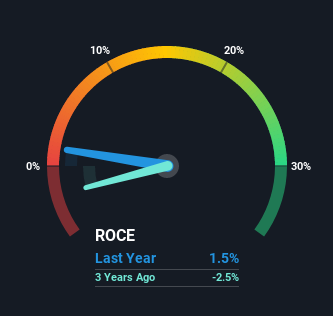- Hong Kong
- /
- Auto Components
- /
- SEHK:1057
Zhejiang Shibao (HKG:1057) Will Be Looking To Turn Around Its Returns
When it comes to investing, there are some useful financial metrics that can warn us when a business is potentially in trouble. Businesses in decline often have two underlying trends, firstly, a declining return on capital employed (ROCE) and a declining base of capital employed. This indicates to us that the business is not only shrinking the size of its net assets, but its returns are falling as well. Having said that, after a brief look, Zhejiang Shibao (HKG:1057) we aren't filled with optimism, but let's investigate further.
Understanding Return On Capital Employed (ROCE)
Just to clarify if you're unsure, ROCE is a metric for evaluating how much pre-tax income (in percentage terms) a company earns on the capital invested in its business. Analysts use this formula to calculate it for Zhejiang Shibao:
Return on Capital Employed = Earnings Before Interest and Tax (EBIT) ÷ (Total Assets - Current Liabilities)
0.015 = CN¥22m ÷ (CN¥2.0b - CN¥570m) (Based on the trailing twelve months to September 2021).
Thus, Zhejiang Shibao has an ROCE of 1.5%. Ultimately, that's a low return and it under-performs the Auto Components industry average of 6.2%.
See our latest analysis for Zhejiang Shibao

While the past is not representative of the future, it can be helpful to know how a company has performed historically, which is why we have this chart above. If you want to delve into the historical earnings, revenue and cash flow of Zhejiang Shibao, check out these free graphs here.
What Can We Tell From Zhejiang Shibao's ROCE Trend?
There is reason to be cautious about Zhejiang Shibao, given the returns are trending downwards. About five years ago, returns on capital were 3.4%, however they're now substantially lower than that as we saw above. Meanwhile, capital employed in the business has stayed roughly the flat over the period. This combination can be indicative of a mature business that still has areas to deploy capital, but the returns received aren't as high due potentially to new competition or smaller margins. If these trends continue, we wouldn't expect Zhejiang Shibao to turn into a multi-bagger.
The Key Takeaway
In the end, the trend of lower returns on the same amount of capital isn't typically an indication that we're looking at a growth stock. Investors haven't taken kindly to these developments, since the stock has declined 62% from where it was five years ago. With underlying trends that aren't great in these areas, we'd consider looking elsewhere.
If you want to know some of the risks facing Zhejiang Shibao we've found 2 warning signs (1 is a bit unpleasant!) that you should be aware of before investing here.
While Zhejiang Shibao may not currently earn the highest returns, we've compiled a list of companies that currently earn more than 25% return on equity. Check out this free list here.
Valuation is complex, but we're here to simplify it.
Discover if Zhejiang Shibao might be undervalued or overvalued with our detailed analysis, featuring fair value estimates, potential risks, dividends, insider trades, and its financial condition.
Access Free AnalysisThis article by Simply Wall St is general in nature. We provide commentary based on historical data and analyst forecasts only using an unbiased methodology and our articles are not intended to be financial advice. It does not constitute a recommendation to buy or sell any stock, and does not take account of your objectives, or your financial situation. We aim to bring you long-term focused analysis driven by fundamental data. Note that our analysis may not factor in the latest price-sensitive company announcements or qualitative material. Simply Wall St has no position in any stocks mentioned.
Have feedback on this article? Concerned about the content? Get in touch with us directly. Alternatively, email editorial-team (at) simplywallst.com.
About SEHK:1057
Zhejiang Shibao
Researches, designs, develops, produces, and sells automotive steering systems and accessories in the People’s Republic of China.
Flawless balance sheet with proven track record.
Market Insights
Community Narratives




